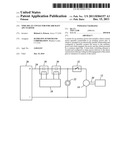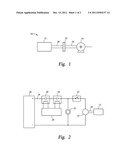Patent application title: Time Delay Contactor For Aircraft APU Starter
Inventors:
Richard A. Poisson (Avon, CT, US)
Richard A. Poisson (Avon, CT, US)
Assignees:
HAMILTON SUNDSTRAND CORPORATION
IPC8 Class: AF02N1108FI
USPC Class:
290 38 R
Class name: Prime-mover dynamo plants electric control electric-starting motor
Publication date: 2011-12-15
Patent application number: 20110304157
Abstract:
A starter for an auxiliary power unit includes a direct current motor
operably connectable to an auxiliary power unit. A clutch is arranged in
an electrically parallel relationship and configured to operably connect
the motor to the auxiliary power unit when engaged, the motor and the
clutch powered by a common input line. A time delay switching element is
located and configured to delay power delivery to the direct current
motor thus providing for full engagement of the clutch prior to
initiation of rotation of the motor.Claims:
1. A starter for an auxiliary power unit comprising: a direct current
motor operably connectable to an auxiliary power unit; a clutch arranged
in an electrically parallel relationship and configured to operably
connect the direct current motor to the auxiliary power unit when
engaged, the direct current motor and the clutch powered by a common
input line; and a time delay switching element disposed and configured to
delay current delivery to the direct current motor thus providing for
full engagement of the clutch prior to initiation of rotation of the
direct current motor.
2. The starter of claim 1, wherein the time delay switching element is latchable in a closed position.
3. The starter of claim 1, wherein the time delay switching element is configured to provide a time delay of about 0.25 seconds to 2.0 seconds.
4. The starter of claim 3, wherein the time delay is about 0.5 seconds.
5. The starter of claim 1, wherein the clutch operably engages the direct current motor with a shaft of the auxiliary power unit.
6. The starter of claim 1, wherein the time delay switching element is one of: a relay, a metal-oxide-semiconductor field-effect transistor, and a thyristor.
7. A method of starting an auxiliary power unit comprising: providing a flow of electrical current to a clutch of a starter; fully engaging the clutch via the flow of electrical current, thus operably connecting a direct current motor to the auxiliary power unit; providing a time-delayed flow of electrical current to the direct current motor of the starter disposed such that it shares a common input line with the clutch; accelerating the direct current motor via the time-delayed flow of current; and transferring rotational energy from the direct current motor to the auxiliary power unit.
8. The method of claim 7, further comprising providing the time delayed flow of electrical current to the direct current motor via a time delay switching element.
9. The method of claim 8, further comprising latching the time delay switching element in a closed position.
10. The method of claim 7, further comprising delaying the flow of electrical power to the direct current motor by about 0.25 seconds to 2.0 seconds.
11. The method of claim 10, further comprising delaying the flow of electrical current to the direct current motor by about 0.5 seconds.
12. The method of claim 7 further comprising operably engaging the direct current motor with a shaft of the auxiliary power unit via engagement of the clutch.
13. The starter of claim 7, wherein the time delay switching element is one of: a relay, a metal-oxide-semiconductor field-effect transistor, and a thyristor.
Description:
BACKGROUND OF THE INVENTION
[0001] The subject matter disclosed herein relates to an auxiliary power unit (APU) for aircraft. More specifically, the subject disclosure relates to a starter motor for an APU.
[0002] An APU is utilized in an aircraft primarily to provide power to start the engines. Aircraft engines have large heavy rotors that must be accelerated to a high rotational speed in order to provide sufficient air compression for self-sustaining operation. An APU solves this problem by powering up the aircraft in two stages. The APU is started by an APU starter, which is a DC electric motor with power supplied by a battery, accumulator, or external power source such as a ground power unit. Once the APU accelerates to full speed, it can provide enough power to start the aircraft's main engines, either by turning an electrical generator or a hydraulic pump, or by providing compressed air to the air turbine of the starter motor.
[0003] When starting the APU, power is supplied to the DC motor and a clutch which engages the APU to begin its operation. Typically, power is supplied to the DC motor and the clutch from the same electrical line, so that when the DC motor is activated, the clutch is simultaneously activated. The result is that the DC motor accelerates to speed before the clutch is completely engaged, and causing a high torque shock on a starter shaft when the clutch engages the shaft. The torque shock can cause damage and/or breakage of the shaft. The art would well receive an APU starter configuration which alleviates the torque shock and reduces damage and/or breakage of the starter shaft when the clutch is engaged.
BRIEF DESCRIPTION OF THE INVENTION
[0004] According to one aspect of the invention, a starter for an auxiliary power unit includes a direct current motor operably connectable to an auxiliary power unit. A clutch is arranged in an electrically parallel relationship and configured to operably connect the motor to the auxiliary power unit when engaged, the motor and the clutch powered by a common input line. A time delay switching element is located and configured to delay electrical current delivery to the motor thus providing for full engagement of the clutch prior to initiation of rotation of the motor.
[0005] According to another aspect of the invention, a method of starting an auxiliary power unit includes providing a flow of electrical current to a clutch of a starter. The clutch is fully engaged via the flow of current, thus operably connecting the direct current motor to the auxiliary power unit. A time-delayed flow of electrical current is provided to a direct current motor of the starter located such that it shares a common input line with the clutch. The direct current motor is accelerated via the time-delayed flow of current, and rotational energy is transferred from the direct current motor to the auxiliary power unit.
[0006] These and other advantages and features will become more apparent from the following description taken in conjunction with the drawings.
BRIEF DESCRIPTION OF THE DRAWINGS
[0007] The subject matter, which is regarded as the invention, is particularly pointed out and distinctly claimed in the claims at the conclusion of the specification. The foregoing and other features, and advantages of the invention are apparent from the following detailed description taken in conjunction with the accompanying drawings in which:
[0008] FIG. 1 is a schematic view of an embodiment of a starter for a auxiliary power unit;
[0009] FIG. 2 is an electrical schematic view of an embodiment of a starter for an auxiliary power unit;
[0010] FIG. 3 is an electrical schematic view of another embodiment of a starter for an auxiliary power unit, and
[0011] FIG. 4 is an electrical schematic view of yet another embodiment of a starter for an auxiliary power unit.
[0012] The detailed description explains embodiments of the invention, together with advantages and features, by way of example with reference to the drawings.
DETAILED DESCRIPTION OF THE INVENTION
[0013] Shown in FIG. 1 is a schematic of a starter 10 for an auxiliary power unit (APU) 12. The starter 10 includes an electric motor, for example, a direct current (DC) motor 14 and a motor shaft 18 extending therefrom. A starter shaft 20 extends from the APU 12 and is connectable to the motor shaft 18 via a clutch 22. When the clutch 22 is disengaged, rotational energy is transferred from the DC motor 14, through the motor shaft 18 and starter shaft 20, and to the APU 12.
[0014] Referring now to FIG. 2, the DC motor 14 and the clutch 22 are arranged in an electrically parallel relationship and are powered by a common input line 24 from a power supply 26. An APU controller 28 controls a flow of current through the input line 24 via signals to one or more contactors 30. When the DC motor 14 is powered by the input line 24, the DC motor 14 accelerates up to a desired rotational speed. Similarly, when the clutch 22 is powered by the input line 24, the clutch 22 operably connects a starter shaft 20 to the motor shaft 18 thus enabling the transfer of rotational energy from the DC motor 14 to the APU 12.
[0015] Located between the DC motor 14 and the clutch 22, in a series relationship with the DC motor 14 is a time delay switching element, for example, a relay 32. When current passes through the input line 24 to the relay 32, time delay control electronics that drive the relay 32 are activated, thus initiating a time delay, before the current flows to the DC motor 14. The time delay effect of the relay 32 allows the clutch 22 to fully engage prior to initiation of acceleration of the DC motor 14 thus reducing torque shock when the clutch 22 is engaged.
[0016] Referring now to FIG. 3, other embodiments include a metal-oxide-semiconductor field-effect transistor (MOSFET) 34 which acts as the time delay switching element. The MOSFET 34 is arranged in a serial relationship with the DC motor 14. When current passes through the input line 24 to the MOSFET 34, time delay control electronics that drive the MOSFET 34 are activated, thus initiating a time delay, before the current proceeds to the DC motor 14. The time delay effect of the MOSFET 34 allows the clutch 22 to fully engage prior to initiation of acceleration of the DC motor 14.
[0017] Referring now to FIG. 4, some embodiments of starter 10 include a switching element which is a thyristor 36. As above regarding the relay 32 and the MOSFET 34, when current is delivered to the thyristor 36 via the input line 24, a time delay is initiated via the time delay control electronics that drive the thryistor 36. Once the thyristor 36 is triggered, it will continue to conduct, or provide current to the DC motor 14 until the voltage across the thyristor 36 is reversed. In other words, the thyristor 36 is latched in a closed position. Further, the thyristor 36 is operable at a wide range of temperatures, and those as low as -50 degrees Celsius or lower. Regardless of the time delay element utilized, the desired range of time delay is in a range of about 0.250 seconds to 2.0 seconds, with a target delay of about 0.500 seconds to allow the clutch 22 to fully engage prior to supplying current to the DC motor 14 to prevent damage to the starter shaft 20 and/or other elements of the starter 10 or APU 12.
[0018] While the invention has been described in detail in connection with only a limited number of embodiments, it should be readily understood that the invention is not limited to such disclosed embodiments. Rather, the invention can be modified to incorporate any number of variations, alterations, substitutions or equivalent arrangements not heretofore described, but which are commensurate with the spirit and scope of the invention. Additionally, while various embodiments of the invention have been described, it is to be understood that aspects of the invention may include only some of the described embodiments. Accordingly, the invention is not to be seen as limited by the foregoing description, but is only limited by the scope of the appended claims.
User Contributions:
Comment about this patent or add new information about this topic:



